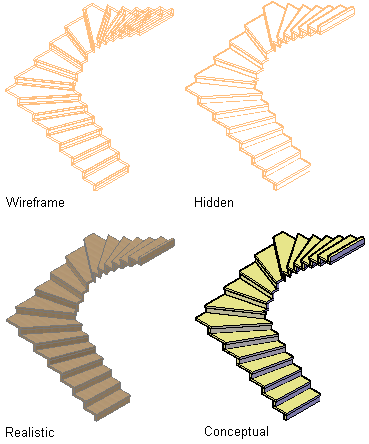Stairs are AEC objects that use flights of treads and risers to accommodate vertical circulation. Stairs also interact with railing objects. You can control the style of the stair, the shape of the landing, the type of treads, and the height and width of the stair run.
Stair Shapes
While strictly rectangular stairs are predominant in modern buildings, in some cases the edges of a flight are not parallel, or they might be curved. Landings can also be non rectangular. Stairs allow the use of nearly arbitrary profiles for the edges of flights and landings. In addition, railings and stringers can be anchored to stairs and can follow the edges of flights and landings. You can create custom stairs from linework or profiles to model different conditions as well.
Landings and Turns
Stairs are created at a specified overall height that requires a total length based on the tread length. Within that length, you can place landings or turns. When you begin to create a stairway, a rectangular box is displayed that represents the width and length of the stair as if it were a straight stairway. As you select consecutive points, depending upon the shape of the stair, landings and turns are created.
Materials in Stairs
In AutoCAD Architecture 2022 toolset, you can assign materials to a stair. These materials are displayed in the Realistic visual style, or when rendered. Materials have specific settings for the physical components of a stair, such as risers, nosing, and treads.

Viewing a stair in different visual styles
AutoCAD Architecture 2022 toolset provides a number of predefined materials for common design purposes, which contain settings for stair components. You can use predefined materials, or modify them for your designs. You can also create your own materials. Object styles provided with the software have appropriate materials already assigned to them.